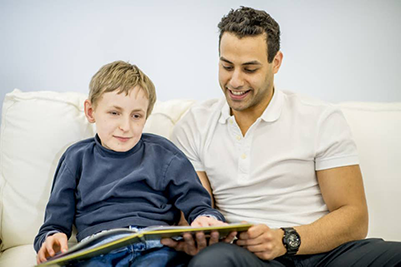Read aloud to children of all ages as often as possible. There is no better way to develop vocabulary, thinking skills, and a feel for the rhythm and pattern of language. Children who are blind or severely visually impaired may require explanations of words and concepts that sighted children grasp easily from pictures. A quiet, relaxed story time with your child (and perhaps a sibling or two) provides you with plenty of time to answer questions and provide additional explanations. For example, your child may not understand specific vocabulary like porridge, bat (the animal), or flour; she may need models or verbal descriptions of unfamiliar animals or unusual characters like those found in books by Dr. Seuss; or she may benefit from an explanation of concepts such as a groundhog seeing its shadow or a hen laying an egg.
Provide your child with as many varied hands-on experiences as possible. This will give him the background to understand both fiction and nonfiction and to choose meaningful topics to write about.
Model braille reading with your child's hands on yours, even if you are not a tactile braille reader. Books with both print and braille (many with colorful and/or tactual illustrations) are available from a variety of sources; see the related document below.
Arrange for your child to meet an older child or adult who reads braille and have him or her read a braille children's book aloud with fluency and enjoyment.
Learn braille yourself! Your interest in reading and writing braille will communicate the importance of literacy to your child in a very tangible way. You will enjoy sharing braille books and simple writing projects with your preschooler; and, as your child starts school, you will have a better understanding of IEP goals related to braille literacy and be able to help with homework. The resource list in this packet provides a variety of ways for parents to learn braille, including self-study, correspondence courses, and courses over the Internet.
Borrow or purchase a Perkins Brailler to use in your home with your child. School districts and early intervention programs will often make braill writers available to families of young children and will give some instruction in their use. Used braill writers are sometimes available for purchase from blind individuals. Consumer organizations, such as the American Council of the Blind and the National Federation of the Blind, will occasionally run advertisements for used braillers in their magazines.
If you don't have a braille writer at home, purchase a slate and stylus. (See Sources of Adapted Materials for more information on purchasing and writing with a slate and stylus.)
Model writing in braille frequently and for a variety of different purposes. Make a shopping list, label cassette tapes, write a short story, or jot down someone's telephone number. Speak words and sounds aloud as you write, and read your message back after the child helps you take the paper out of the braille writer or slate.
Visit FamilyConnect's Literacy Resources: Teaching Children Who Are Blind or Have Low Vision to Read and Write area for more articles and ideas.
